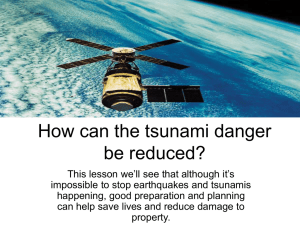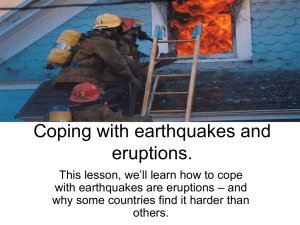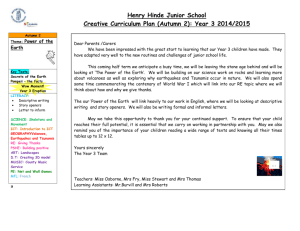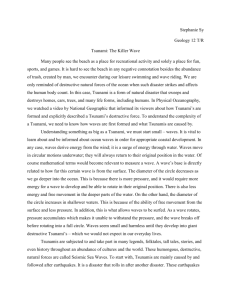GEOSCIBONUS
advertisement
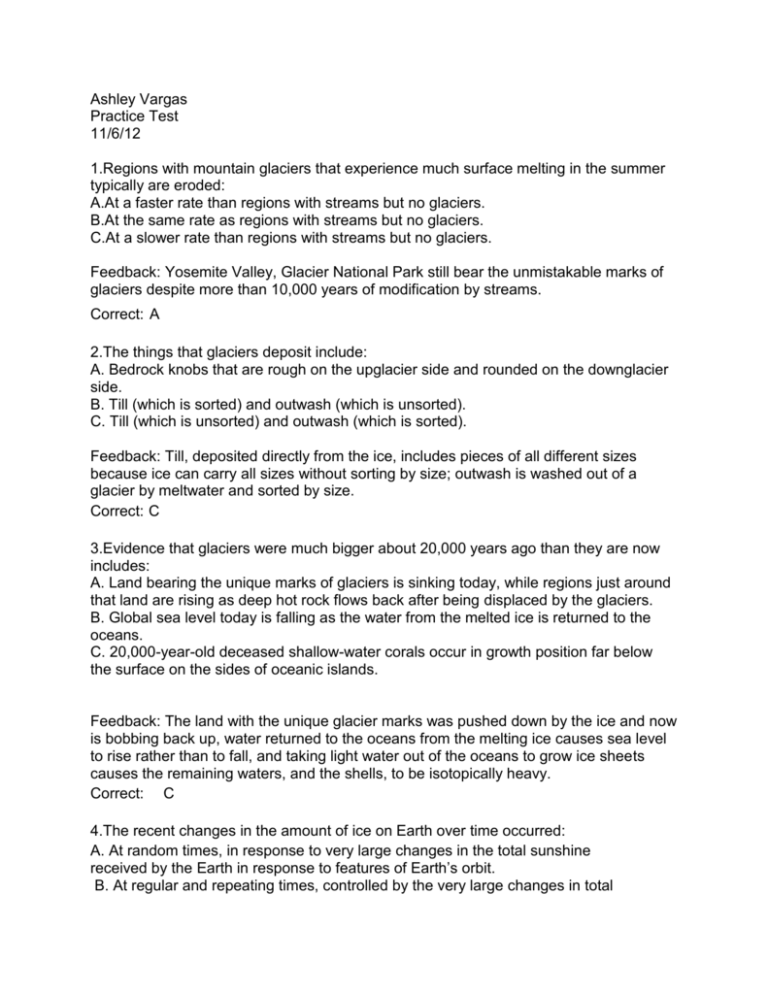
Ashley Vargas Practice Test 11/6/12 1.Regions with mountain glaciers that experience much surface melting in the summer typically are eroded: A.At a faster rate than regions with streams but no glaciers. B.At the same rate as regions with streams but no glaciers. C.At a slower rate than regions with streams but no glaciers. Feedback: Yosemite Valley, Glacier National Park still bear the unmistakable marks of glaciers despite more than 10,000 years of modification by streams. Correct: A 2.The things that glaciers deposit include: A. Bedrock knobs that are rough on the upglacier side and rounded on the downglacier side. B. Till (which is sorted) and outwash (which is unsorted). C. Till (which is unsorted) and outwash (which is sorted). Feedback: Till, deposited directly from the ice, includes pieces of all different sizes because ice can carry all sizes without sorting by size; outwash is washed out of a glacier by meltwater and sorted by size. Correct: C 3.Evidence that glaciers were much bigger about 20,000 years ago than they are now includes: A. Land bearing the unique marks of glaciers is sinking today, while regions just around that land are rising as deep hot rock flows back after being displaced by the glaciers. B. Global sea level today is falling as the water from the melted ice is returned to the oceans. C. 20,000-year-old deceased shallow-water corals occur in growth position far below the surface on the sides of oceanic islands. Feedback: The land with the unique glacier marks was pushed down by the ice and now is bobbing back up, water returned to the oceans from the melting ice causes sea level to rise rather than to fall, and taking light water out of the oceans to grow ice sheets causes the remaining waters, and the shells, to be isotopically heavy. Correct: C 4.The recent changes in the amount of ice on Earth over time occurred: A. At random times, in response to very large changes in the total sunshine received by the Earth in response to features of Earth’s orbit. B. At regular and repeating times, controlled by the very large changes in total sunshine received by the Earth in response to features of Earth’s orbit. C. At regular and repeating times, controlled by redistribution of sunlight on the surface of the Earth in response to features of Earth’s orbit, even though total sunshine received by the planet didn’t change much. Feedback: The orbital changes have little effect on the total sunshine, but do move that sunshine around, with important consequences. And the orbital changes are far from random, having very strong regularities. Correct: C 5. Glaciers form where: A.Melting exceeds snowfall for a long enough time. B.Rocks are being raised by tectonic motions. C.Snowfall exceeds melting for a long enough time. Feedback: Many high mountains are free of ice, and some warm places are being raised tectonically. The way to make a glacier is to pile up more snow than melts. Correct: C 6.Hot spots: A.Bring caffeine up beneath the Capitol Building to stir up trouble in Congress. B.Rise from as deep in the mantle as the core-mantle boundary to the surface of the Earth, bringing up heat and feeding volcanoes. C.Are found only under continents Feedback: Earthquakes make sound waves that go through the whole Earth, and go slower through hotter, less-dense rocks. By putting out listening devices called seismometers around the Earth, and listening to the waves from many earthquakes in many places, scientists can map the hotter regions, and find that towers of hot rock come up from way deep in the Earth in some places. Correct: B 7. Major differences between Mt. St. Helens and Hawaiian volcanoes include: A. Mt. St. Helens is a low-silica, explosively erupting shield volcano, and Hawaii has medium-to-high-silica, quietly erupting stratovolcanoes. B. Mt. St. Helens is a medium-to-high-silica, explosively erupting stratovolcano, and Hawaii has low-silica, quietly erupting shield volcanoes. C. Mt. St. Helens is a low-silica, quietly erupting stratovolcano, and Hawaii has medium-to-high-silica, explosively erupting shield volcanoes. Feedback: The low-silica lava from the Hawaiian hot spot flows easily without large explosions, so the lava spreads out to make broad, gentle volcanoes that look like shields of medieval warriors. Correct: B 8. The deepest earthquakes are rare, and differ in some ways from the more-common type of quakes. These deepest earthquakes probably: A. Are the shaking of the ground caused by “implosion” as minerals rearrange to denser forms as the pressure on them rises in downgoing slabs B. Are caused by Pepsi machines exploding after being kicked by Coke drinkers to cause Gatorade to squirt out. C. Are caused by Coke drinkers kicking Pepsi machines and then jumping back when Gatorade squirts out. Feedback: “Implosion” is the currently favored idea. As subduction zones take rocks deeper where pressure is higher, the building blocks tend to reorganize to take up less space, shifting from, say, a one-on-top-of-another pattern to a fit-in-the-space-betweenthose-below pattern. Correct A 9.Which ocean is almost entirely encircled by volcanic arcs in a “Ring of Fire”: A. Indian. B. Pacific. C. Arctic. Feedback: The Andes, the mountains of central America, the Cascades, the Aleutians, Japan, New Zealand and others ring the Pacific in a subduction-zone ring of fire. subduction-zone volcanism around the “Southern Ocean” that encircles Antarctica, but none of the other oceans is encircled the way the Pacific is. Correct B 10. The size of a typical sandy beach, averaged over a few decades, is usually controlled by: A. The balance between loss of sand blown away to make sand dunes, and gain of quartz sand from weathering of the granite bluffs just behind the beach. B. The balance between net transport of sand to the beach by wintertime storms, and removal of sand from the beach by smaller summertime waves. C) The balance between sand supply from rivers or from coastal erosion, and sand loss to deep water. Feedback: On average, beaches lose sand to deep water, and will shrink unless that sand is replaced. Glaciers contributed some of the sand in places, but are not important now for typical beaches. Correct Answer(s): C 11. Geologically speaking, the water table: A.Rises in elevation during times of drought as trees suck it up, and sinks during rainstorms as trees quit pulling up water because they are well-watered. B.Rises during or soon after rainstorms as spaces fill up, and sinks during droughts as water drains away. C.Never changes its elevation, because it is pinned by the creeks. Feedback: As trees suck up water during droughts, air enters spaces where water once was, so the water table (which is the bottom of the region with some air in spaces) must sink in elevation. Creeks do change in elevation between rain and drought (floods happen…), and while there are random elements in the world, this is surely not one of them. (Whenever someone claims something is random, at least suspect that the person is really saying “I don’t know what I’m talking about, and I’m too lazy to find out.”) And while there might be bottled water in the Capitol, geologically speaking, that is not the right answer. Correct: B 12. Given the materials presented in this class about the formation of caves, it is likely that most large caves are formed: A) In limestone in moist climates. B) In limestone in dry climates. C) In sandstone in moist climates. Feedback: Caves require easily dissolved rock, and water to dissolve that rock. In really dry climates, limestone is a resistant rock that stands in huge cliffs. Correct A 13. Tsunamis: A) Are like tornadoes; they can be predicted with some accuracy seconds to hours before they strike in most cases, allowing quick warnings to save many lives. B) Are like the weather; they can be predicted fairly accurately days in advance, allowing wise planning. C) Are completely unpredictable on all time scales. Feedback: Because tsunamis are triggered by earthquakes, among other things, and we cannot predict earthquakes accurately, we cannot make months-in-advance predictions of tsunamis. The p-waves from the earthquakes that cause the most common tsunamis move much more rapidly than the tsunamis do, allowing timely warnings; however, because the tsunamis get where they are going in hours or less typically, not much time is available. Correct:A 14. Tsunamis: A.Always are huge and destructive. B.Are completely unpredictable, so there is nothing we can do about them. C.Can be predicted with some accuracy seconds to hours before the waves strike in most cases, allowing quick warnings to save many lives. Feedback: Because tsunamis are triggered by earthquakes, among other things, and we cannot predict earthquakes accurately, we cannot make months-in-advance predictions of tsunamis. The p-waves from the earthquakes that cause the most common tsunamis move more rapidly than the tsunamis do, allowing timely warnings; however, because the tsunamis get where they are going in hours or less typically, not much time is available. Correct:C 15. At Cade's Cove in the Great Smoky Mountain National Park, there is an unusual arrangement of rocks where older rocks are sitting on top of younger rocks, though neither layer has been overturned. This is because: A.The younger layer subducted under the older layer. B.The younger layer was injected as molten material under the older rock and then solidified. C.The older layer was thrust over the younger layer by the forces of obduction. Feedback: The Great Smokies are an example of obduction, as are the Ridge-andValley mountains of the folded Appalachians, which include Penn State's University Park campus. Correct: C 16.What tectonic setting is primarily responsible for producing Mt. St Helens? A) Hot Spot B) Push-together Subduction C) Pull-Apart Feedback: Mt. St. Helens sits above a subduction zone, where one tectonic plate goes below another as they come together. Correct: B 17. Geological evidence based on several radiometric techniques has provided a scientifically well-accepted age for the Earth. Represent that age of the Earth as the 100-yard length of a football field, and any time interval can be represented as some distance on the field. (So something that lasted one-tenth of the age of the Earth would be ten yards, and something that lasted one-half of the age of the Earth would be fifty yards.) On this scale, how long have you personally been alive? A) 1 yard. B) 1 inch. C) Much less than the thickness of a sheet of paper. Feedback: If the 4.6 billion years of Earth history are 100 yards, then the few thousand years of written history are just one-millionth of that history, just over the thickness of a sheet of paper. And your small piece of written history must be only a small fraction of a sheet of paper, roughly 1/200th or so.Points Correct:C 18. One practical radioactive system used to date lava flows involves: A) The solid potassium-40, which decays to solid argon-40. B) The solid potassium-40, which decays to the gas argon-40. C) The solid potassium-40, which decays to the solid moosemossium-41. Feedback: Potassium-40 is common in solid minerals, and decays to produce the gas argon-40. And despite his great contributions to humanity, no one has named an isotope after moose moss (the favorite food of Thidwick, for you Dr. Suess fans).Points Correct: B Scientists often speak of consensus—the scientific community agrees that a particular theory is better than the competitors. What is such scientific consensus based on? A) A single experiment had an outcome that was predicted accurately by the favored theory and not by the competitors. B) A number of different experiments by different people that all had outcomes that were predicted accurately by the favored theory and not by the competitors. C) Statements in the old textbooks that the scientists studied when they were in school. D) The insistence of a single scientist that he or she is correct. E) The decision of the Nobel prize committee to give the inventor of the idea a lot of money. Feedback: Agreement on scientific theories is a contentious, drawn-out, and sometimes acrimonious business. Scientists are no better (and no worse!) than everybody else: we think we are right and those who disagree with us are dunderheads! I put forward my idea, and the experiments that I did that show the idea is a good one... then everybody else piles on and pooh-poohs my idea. BUT, they go out and do experiments that try and show my ideas are wrong... and they can't do it! So eventually all those experiments accumulate, and finally people agree that my idea is a good one. (Sometimes accompanied by a sneer: "...but of course I knew that all along. I just didn't bother to publicize it..." I told you, scientists are no better and no worse than the rest of the world.) Correct Answer(s): B 19. Your job depends on you finding the best available information on a particular technical topic. Where should you concentrate your search if you want to do it right and keep your job? A) Get on the web and go looking for the pages posted by “think-tanks” headquartered near Washington. B) Scan databases of newspaper articles to find the views of public figures on the technical issue. C) Find and study refereed scientific articles in learned journals. Feedback: No source of information is perfect, but the refereed articles in learned journals put immense effort into “getting it right”. The web has reliable information, of course, but probably most of the information on the web is not especially reliable. The web is very inexpensive, and lots of people put junk on it. Think tanks also often are pushing an agenda, and try to “spin” information their way. Most newspapers are around for the long haul, and try to make the news fairly accurate, although some newspapers do have agendas, and the editorial pages are not especially accurate. But, if the report is on the views of a public figure, the newspaper may accurately report what the public figure said, but what the public figure said may be less than completely accurate. Some magazines are quite good and careful, but many are pushing a belief or just overhyping things to tease you into buying the magazine. And while you are welcome to believe that drinking a particular cola makes you sexy… don’t count on it. Correct Answer(s): C 20. The peer review process, in which scientists submit write-ups of their ideas and experiments to a set of colleagues who judge how good the ideas are before the ideas can be published, is: A) The way all publications do business, including the popular press such as the New York Times, Centre Daily Times, National Enquirer, etc. B) A way for the Scientific Establishment to maintain control over ideas and theories. C) A useful and important, even if imperfect, mechanism of quality-control for the scientific literature. Feedback: The peer review process applies to scientific publications and works like this: I get an idea and do some experiments to test it and write down the results of the tests. I send the paper to a scientific journal (Nature, Journal of Geophysical Research, etc.) and the editor of the journal sends it to a number of other scientists who can best judge whether my methods are good, whether my results are new and interesting, and whether my paper ought to be published. They don't base their judgements on whether they like me or not or whether I'm a nice guy/gal or not (or at least they ought not base their judgments on that, though it does happen: we're human!). They don't base their judgements on whether my ideas are popular or unpopular. They are only supposed to ask: is this really new (i.e., did somebody else think of this and publish it already somewhere else?) and are the methods used accurate and repeatable? Correct Answer(s): C 21. What is more accurate about the Earth? A) The Earth is formed of concentric layers (something like an onion--a central ball with a shell around it, and a shell around that…); when the planet melted, it separated into layers. B) The Earth is homogeneous; when it melted, it got all mixed up. C) The Earth is formed of concentric layers (something like an onion--a central ball with a shell around it, and a shell around that…), but with a giant hole on one side where the moon-making collision blasted pieces off. Feedback: The planet is onion-like, with an inner core, then an outer core, a mantle (which has several sub-layers), and a crust. The moon-making collision did happen, but the planet got hot enough to separate again. The planet separated after melting largely or completely, with the densest stuff falling to the center and the lowest-density stuff floating to the top. Correct A 22. The Earth has a fascinating history, which this class has just begun to explore. Which is more nearly correct, according to the scientific interpretation presented in the text? A) The Earth formed in the Big Bang, about 4.6 billion years ago. B) The Earth formed about 4.6 billion years ago, well after the Big Bang, as materials made in stars fell together to form the planet. C) The Earth formed in the Big Bang, about 6000 years ago. Feedback: The Big Bang is estimated as having occurred about 14 billion years ago. Stars that eventually formed in the wake of the Big Bang led to production of elements such as iron and silicon that are common in the Earth—we are formed from second-generation stardust, which “got it together” to make the planet about 4.6 billion years ago. Correct B 23.National Parks are: A) Regions containing key biological resources that have been set aside for the enjoyment of future generations. B) Regions containing key geological resources that have been set aside for the enjoyment of the present generation. C) Regions containing key biological, geological or cultural resources that have been set aside for the enjoyment of the present generation and future generations. Feedback: Old Faithful, the giant sequoias, and Mesa Verde’s cliff dwellings are waiting for you, and your grandchildren. Correct: C 24. In chemistry, the type of an atom (what element it is) is determined by: A) The number of protons it contains in its nucleus. B) The number of neutrons it contains in its nucleus. C) The number of protons it has in a cloud around the nucleus. Feedback: Physicists change the name when the number of charged, massive protons in the nucleus changes. Adding one proton makes a HUGE difference to how an atom behaves, and so deserves a new name. The neutrons hang around in the nucleus to keep the protons from kicking each other out. Exchanging electrons is important, but doesn’t change the element type. Correct A 25. We speak of elements, such as gold, or oxygen, or iron. If you got some gold, and started dividing it into smaller and smaller pieces, the smallest piece that would still be called "gold" would be: A) An atom. B) A proton. C) A quark. Feedback: We can break matter down into atoms (Greek for “not cuttable” because the Greeks didn’t have atom smashers or other exotic tools that would allow cutting atoms into smaller pieces). All of the wrong answers here are smaller pieces of atoms, but they wouldn’t be gold any more; you can make any of the elements out of these pieces. Correct A
